hydraulic control valve types
Types of Hydraulic Control Valves A Comprehensive Overview
Hydraulic control valves are essential components in hydraulic systems, playing a crucial role in managing the flow and pressure of hydraulic fluid. By regulating and directing the flow to various parts of the system, these valves ensure that machinery operates efficiently and effectively. Understanding the different types of hydraulic control valves is vital for anyone involved in the design or maintenance of hydraulic systems.
1. Directional Control Valves
Directional control valves are used to control the path of hydraulic fluid within a system. They can direct fluid flow in various ways, which is essential for machines that require movement in multiple directions. The most common types of directional valves are the spool valves and poppet valves. Spool valves use a sliding spool to change the direction of flow, while poppet valves utilize a spring-loaded poppet that opens or closes the flow path. These valves are often found in applications such as excavators, forklifts, and other machinery that require precise movement.
Pressure control valves manage the pressure within a hydraulic system, ensuring that it operates within safe limits. There are several subtypes of pressure control valves, including relief valves, pressure reducing valves, and sequence valves. Relief valves protect the system from overpressure by diverting excess fluid when pressure exceeds a set point. Pressure reducing valves lower the incoming pressure to a desired level, which is crucial for protecting sensitive components. Sequence valves ensure that actuators operate in a specific order, making them useful in complex systems where timing is essential.
hydraulic control valve types

3. Flow Control Valves
Flow control valves regulate the flow rate of hydraulic fluid to various components. This is critical for controlling the speed of actuators and ensuring that they operate at optimal performance levels. Common types of flow control valves include needle valves, orifice valves, and flow control with a check valve. Needle valves provide precise flow adjustments, while orifice valves restrict flow based on a fixed opening. Check valves prevent backflow, which is important for maintaining system integrity.
4. Application-Specific Valves
In addition to the standard types of hydraulic control valves, there are also application-specific valves designed for unique circumstances. These include proportional valves, which offer variable control of flow and pressure, and servo valves, which provide precise control for sophisticated systems. These advanced valves are increasingly employed in robotic applications, aerospace, and other high-tech industries.
In conclusion, hydraulic control valves come in various types, each serving a distinct function within hydraulic systems. By understanding the differences among directional, pressure, and flow control valves, as well as specialized options, engineers and technicians can design and maintain hydraulic systems more effectively, ensuring reliability and performance in a multitude of applications.
-
Breakthrough in Domestic Low Temperature Valve Technology in ChinaNewsAug.18,2025
-
From Machinery to Intelligent Brain: The Digital Transformation Wave of the Valve IndustryNewsAug.18,2025
-
PCVEXPO 2025NewsAug.18,2025
-
The Key to Fluid Control: Exploring the Advantages of Ball Valves in Industrial SystemsNewsJul.09,2025
-
The Versatile World of 1, 2, and 3 Piece Ball ValvesNewsJul.09,2025
-
Stainless Steel Ball Valves: The Ideal Choice for Efficient Flow ControlNewsJul.09,2025
-
Optimizing Fluid Control with Ball Float ValvesNewsJul.09,2025




